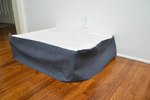Things You'll Need
16-foot vinyl rance fence with a 6-inch rail
Hand saw
Sharpie
Measuring tape
Three 10-foot sections of PVC pipes
PVC pipe cutter
Sixteen “T” slip connectors
PVC glue
Twenty 90-degree slip connectors
Four slip end caps
The broad jump is a part of obedience and agility competitions for dogs. It requires a set of boards that the dog can leap across, and measures the horizontal distance of a jump rather than the height. As a general rule, the ideal distance for a dog's jump is twice his height: a two-foot tall dog should jump four feet. There are specific requirements for broad jump obstacles used in competitions: It is up to you how closely you want to make your training obstacle conform to competition requirements.
Cut the 16-foot length of vinyl railing into four 4-foot sections. This can be done using the handsaws that are available at most major hardware stores.
Cut the three 10-foot sections of PVC pipe into the following sections, using the pipe cutter: twenty-two 1-3/4-inch lengths, sixteen 5-inch lengths, twelve 4-inch lengths, and five 30-inch lengths.
Glue eight of the 4-inch pipe sections to the center of eight T connectors.
Glue eight of the 1-3/4-inch pipe sections to the center of eight T connectors.
Glue sixteen of the 90-degree slip connectors to the pipe and T connectors assembled in Steps 3 and 4. Make sure that the 90-degree connector is perpendicular to the T connector. When this step is complete, you will have sixteen pipe segments, each with a T connector on one end and a 90-degree slip connector on the other.
Glue the last four 4-inch pipe sections to the last four 90-degree slip connectors.
Assemble the first side rail. Place two of the 1-3/4-inch pipe/T-connector pieces in a line, followed by four of the 4-inch pipe/T-connector pieces, followed by two more 1-3/4-inch pipe /T-connector pieces. Between each pipe/T-connector section, glue another 1-3/4-inch pipe piece as a separator. Add a 4-inch pipe/90-degree connector piece to either end of the rail.
Repeat the process to create an exact duplicate rail for the other side.
Glue a 5-inch piece of PVC pipe into the inside part of the 90-degree connectors. There will be sixteen of these, eight in the 1-3/4-inch pipe/T-connector pieces and eight in the 4-inch pipe/T-connector pieces.
Take the fence rail pieces and slide them onto the 5-inch sections you added in Step 9. Each fence rail will slide over two pieces of pipe. On the first side, slide the rail pieces onto the pipe. On the second side, bring the assembled pipe rail to the board and place it into the fence rail siding.
Glue the end caps to the 30-inch pipe sections and then glue the 30-inch sections into the four corners of the broad-jump apparatus.
Tips
The assembly described here is for home practice, and has the higher risers in the middle. For regulation practice, the risers should ascend higher in a single direction. Alter this pattern by changing the placement of short pipe sections to longer pipe sections.
For regulation purposes, the center of the risers should be painted a contrasting color.
This assembly creates a broad jump that is four boards wide. You can increase the length of the broad jump by repeating this process to create a larger broad -ump apparatus.
Warnings
Use caution when cutting PVC pipes.
Glue carefully, as PVC glue is permanent.





